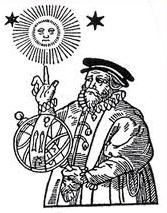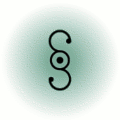As a point of departure in the search for meaning in the planetary configurations, it may be useful to revise the connotations as they have evolved in common astrology. The symbolism presented here follows the relatively modern tradition, which settled into this form by the early centuries AD, in Europe, India and the Arab world. The book Sky Knowledge discusses some of the origins, details and inter-cultural parallels of the symbols tabled here.
Planets
Traditional astrology usually assigns to the planets certain aspects of one’s personality. Then from whichever sector/sign they appear to reside in, they acquire various zodiacal influences (see Ecliptic Sectors table below). It must be remembered that these formed part of a geocentric cosmology. Even so, the connotations may still be relevant to a heliocentric system, where the planets are highly individual bodies spread around the Sun like children. We then may wonder if each planet has a special significance for the Sun, which is then imparted to us (individual humans, or Earth-dwellers generally).
Planet Weekday Character Influence Color SUN (EARTH) Sunday soul, self, vitality central, judgmental gold, red MOON Monday emotion, senses, caring, home, security waxing is positive,
waning is negativesilver, white MARS Tuesday energy, will, action, violence negative brown MERCURY Wednesday intellect, speech, learning, communication changeable pink JUPITER Thursday knowledge, fortune, expansion, opportunity positive green VENUS Friday desires, peace, relation to others, pleasure positive blue SATURN Saturday organization, duty, solitude, sorrow negative black, purple
Ecliptic Sectors
The plane upon which the orbit of the Earth lies is called the ecliptic, with the Sun at the focus of that orbit. But all the planets orbit on planes not far from our own, and are found scattered in a band extending from the middle (equator) of the Sun. So it is not awkward to apply the traditional zodiacal twelfths (30° sectors) to this band, have the Sun at the center, and have the planets journey through each sector in turn. The sectors are listed here with their traditional geocentric zodiacal signs and symbolisms.
Sector Symbol Duplet division Triplet Quadruplet Character Ari ram male/active cardinal fire assertive, energetic, innovative Tau bull female/passive fixed earth sensual, practical, stubborn Gem twins male/active mutable air inquisitive, communicative, changeable Cnc crab female/passive cardinal water sensitive, caring, conventional Leo lion male/active fixed fire proud, dramatic, generous Vir virgin female/passive mutable earth critical, modest, helpful Lib balance male/active cardinal air fair, companionable, indecisive Sco scorpion female/passive fixed water intense, secretive, transforming Sgr archer male/active mutable fire freedom-loving, optimistic Cap fish-goat female/passive cardinal earth prudent, ambitious, traditional Aqr water-bearer male/active fixed air detached, friendly, quirky Psc pair of fish female/passive mutable water imaginative, kind, impressionable
Nakshatras
In Indian astrology, a nakshatra is one twenty-seventh of the Moon’s passage through our sky. This is not a measure of the Moon’s illumination phase, but of her location with respect to the background constellations. This system was exported to Southeast Asia, and has similarities with the manâzil of Arabic astrology. There are also many points of correspondence with the xiu (lunar mansions) of Chinese astrology.
Name General meaning Indian symbol, character Thai symbol Star Arabic manzil Ashwini Horse god-twins horse head, divine physicians horse αβ Ari Two signs Bharani Bearer of new life vagina, death, dharma hen 41 Ari Belly Krttika Cutter razor, fire chicks η Tau Many little ones Rohini Red (cow) chariot, temple, creator animal nose α Tau Follower Mrgashira Deer’s Head deer head (antlers), the Moon deer head λ Ori White spot Ardra Moist teardrop, head, storm & destruction royal umbrella α Ori Brand Punavasu Prosperity,
Return of lightbow & quiver, divine mother golden boat β Gem Forearm Pushya Nourish, Flourish udder, lotus, priest-god anchor, cotton δ Cnc Gap, Crib Aslesha Embrace serpents house, rice-bin ε Hyd Glance (of the lion) Magha Glory throne, ancestors monkey, plow α Leo Forehead Purva-phalguni Former Red One front legs of marriage-bed, marital bliss front ceiling δ Leo Lion’s mane Uttara-phalguni Latter Red One back legs of marriage-bed, favours back ceiling β Leo Changer of weather Hasta Hand hand, the Sun hand δ Crv Barker Chitra Bright pearl, jewel, architect-god crocodile eye α Vir Unarmed Svati Independent, Sword wheat sprout, wind female elephant α Boo Covering Vishakha Forked, Branched triumph arch, Indra & Agni arm, buffalo-horns α Lib Claws Anuradha Follower of Radha lotus, friendship crossbow, bear δ Sco Crown of forehead Jyeshtha Eldest umbrella, chief of gods big elephant α Sco Heart Mula Root, Basic elephant goad, dissolution small elephant λ Sco Sting Purva-ashadha Former Victor fan, water male rhino δ Sgr Ostriches Uttara-ashadha Latter Victor elephant tusk, universal gods female rhino σ Sgr City, District Shravana* Ear, Hear, Learned ear, footprints, preserver meditator α Aql Luck of the swallower Dhanishtha Abundance, Richest flute, drum, earth’s abundance teapot, fishtrap β Del Luck of the luckiest Satabhisha,
Satataraka100 Physicians empty circle, cosmic waters dragon λ Aqr Luck of the veiled Purva-bhadrapada Front Good Feet front legs of death-bed, dragon, one-footed goat lion β Peg Top spout of bucket Uttara-bhadrapada Back Good Feet back legs of death-bed, serpent of the deep lioness γ Peg Lower spout Revati Opulent beater, fish, traveler’s nourisher carp ζ Psc Belly of the fish
*Astrologers often insert an extra nakshatra called Abhijit (α Lyr) before Shravana, every four months or so. This is to keep the 27-part system more in sync with the Moon’s orbital period of 27.23 days. In the almanacks, the sky is divided strictly into 27 parts and this intercalary sign is ignored.
Aspects
Geometric alignment is an important consideration. Here, traditional non-cardinal angles such as Trine, Quintile and Sextile have been rationalized into a simpler system; a suggested reading for acute and obtuse angles is given.
Label Name Angle Character CONJ Conjunction zero° connected, working as one SQR Square 90° in conflict, needing adaptation OPP Opposition 180° in tension, needing balance acute (non-cardinal) less than 90° seeking harmony obtuse (non-cardinal) between 90° and 180° unrelated, independent

